Bali’s archaeological sites seem to stand outside and beyond the reaches of time. Traces of the old Hindu civilisation can be found in many corners of the island, and the excitement one feels when strolling along their ancient pathways is indescribable.
PURA KEBO EDAN
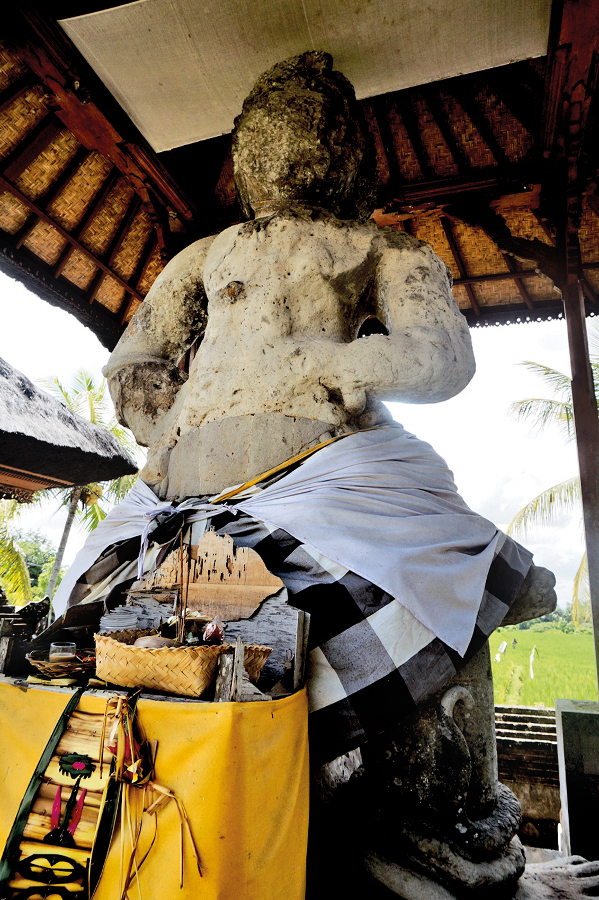
Before we get started, here’s a quick lesson in Bahasa Indonesia: “Pura” means temple, “kebo” means buffalo and “edan” means crazy. Put it all together we have “Pura Kebo Edan”, which loosely translated to “Temple of the Crazy Buffalo”. No, there is not one single buffalo in the temple compound; the name is derived from the name of one of the most legendary ancient local figures, Kebo Edan. The temple is located in Pejeng Village, Tampaksiring. If you’re coming from the direction of Goa Gajah, the temple is located on the left side of the road before Gunung Kawi.
SEE:
Pura Kebo Edan is interspersed with quite a number of century-old statues, with one being especially appealing. It is the Ciwa Bhairawa statue (a representation of God Shiva), which is shaped to have all the important aspects of a male human body, including the genitals. Of course, one is not a big deal; but six male genitals on one body? Now that’s really something!
LOCAL LEGEND:
Being a Balinese Hindu temple, Pura Kebon Edan has been a place of worship for centuries now. However, the statue of Ciwa Bhairawa with its six genitalia has created some controversy, for it was a distraction to those who were praying – especially the female visitors. However, men, too, gazed enviously at the statue and wondered if they measured up; and this corrupted the temple’s function as a place of worship. This is why the statue’s lower body is now swathed in a checkered loincloth. A lot of Balinese Hindus still pay homage at the temple every now and then, though visitors have dwindled, and, this time, they’re there solely for religious and spiritual purposes.
GOA GAJAH
Loosely translated to “Elephant Cave”, Goa Gajah near Ubud was built as a meditation site in the 11th century, with various structures that showcase Hindu influences from the 10th century, and some elements of Buddhism from earlier 8th century. Built on a hillside where two streams meet to form a river junction, the site was deemed sacred and the temple was built for prayer and enclosed meditation.
The name of this place may give the impression that it’s an elephant sanctuary, but Goa Gajah is an archaeological site of significant historical value that makes it as one of the Bali’s most visited attractions, both by visitors and locals alike. In 1995, Goa Gajah was added to the cultural category of the UNESCO World Heritage Tentative List.
SEE:
The main attraction at Goa Gajah is the cave itself. Entrance to the cave is a menacing giant face with its mouth wide opened. While there are various carvings of animal and forest motifs on the outer rock face, the giant face of the doorway is considered to be that of an elephant’s.
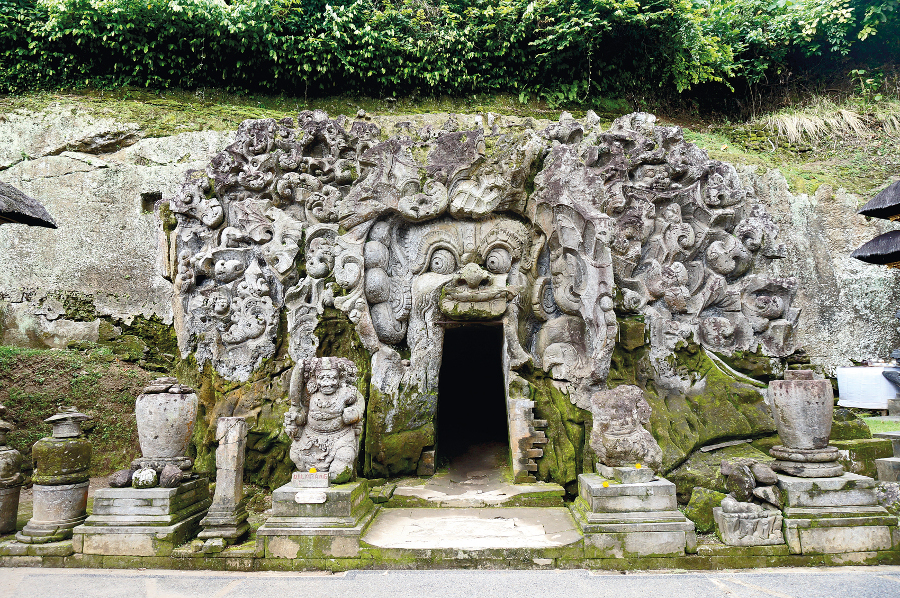
As you enter through the dark, narrow passage, the cave abruptly ends in an intersection. Inside the shallow cave you’ll find the statue of Ganesha (the Hindu deity reminiscent of an elephant) to the left passage and, to the right, three stone idols wrapped individually in yellow, red and black cloth. The are also some spots with a number of hollows which are believed to be the places where priests once sat to meditate.
In addition to the cave, the Goa Gajah complex also houses two bathing pools. Excavated in 1954, the pools feature Hindu angel statues holding vases that act as water spouts. A large, traditional Balinese meeting hall can also be found on the courtyard area, as well as a collection of large ancient stone carvings, some which have been restored to their former glory.
Goa Gajah is surrounded by Hindu temples. With that being said, Buddhist culture dominates the northern side of the temple complex, while across the river in the south is predominantly Shivaite. Other than the religious and archaeological significance, the real draw of Goa Gajah is the beautiful surrounding. The Cave only takes minutes to explore, however rice paddies, gardens, giant banyan trees, and stone steps lead to other beautiful settings such as the rivers and even a coffee shop are also worth exploring. It should take less than 60 minutes to explore the whole premises.
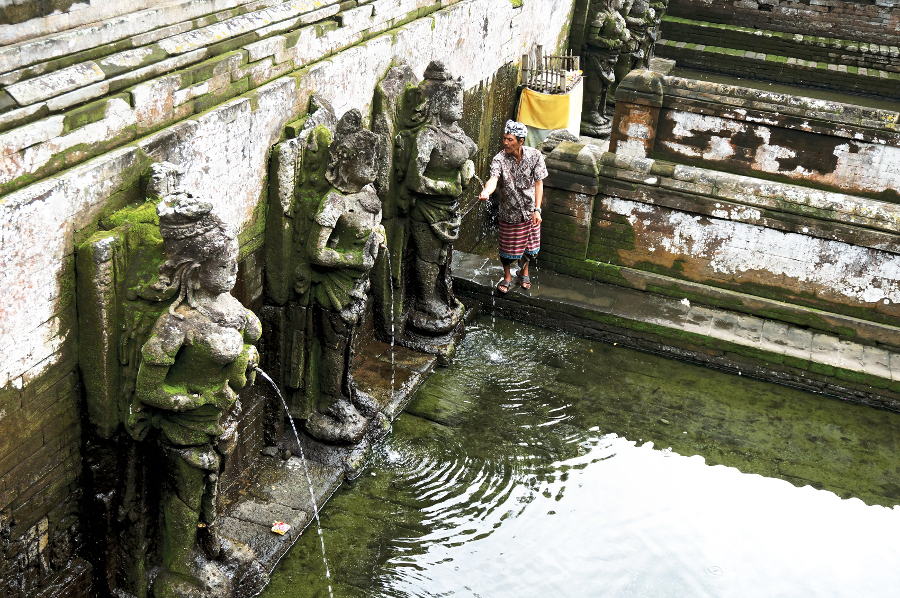
LOCAL LEGEND:
There are various theories that suggest the origin of Goa Gajah’s name. One of the theories said that the Petanu River, one of the rivers running through the site, was originally called “Lwa Gajah”, meaning the “Elephant River”. Other sources state that the ‘Gajah’ or elephant aspect came from the stone figure inside the cave depicting the Hindu lord Ganesh, who is characterised by an elephant’s head. The leading theory suggests that Goa Gajah was used as a sanctuary by Hindu priests who dug the cave entirely by hand. With that being said, a number of relics and the close proximity of a Buddhist temple suggests that the site held special significance to early Buddhism on the island.
Despite the ancient significance of the Elephant Cave, the last excavation took place during the 1950s; many sites still remain unexplored.
GUNUNG KAWI
Gunung Kawi is one of the island’s most popular, unique sites for visitors to marvel at, and the local Hindus to pay homage to their gods and ancestors. Nestled in the midst of Tampaksiring’s brilliant, natural landscape, this archaeological site portrays the atmosphere of ancient legends and long lost tales of forgotten Balinese kings. Gunung Kawi remains an important source for holy water that has always been central to Hindu Balinese rites. The Balinese Hindus believe Pakerisan River to be of religious significance, as it transforms into holy water after passing the temple.
Your journey to the temple begins by following the scenic steps down to the Pakerisan River, passing the surrounding rice terraces and lush foliage. Some of the locals set up their little shops along the route, offering their locally-made arts and crafts as well as cold drinks – they’re not pushy so you should be fine.
A trip to Goa Gajah can be combined with a visit to another archaeological site, Yeh Pulu, which is located just a five-minute drive away in the neighbouring village.
SEE:
Rock-cut Balinese Hindu shrines, carved into some eight-meter high sheer cliff faces. Ten incredible rock-cut shrines are featured in this temple complex, which is one of the most remarkable sites on the island. Because they are so well sheltered, the carvings here have aged exceptionally well.
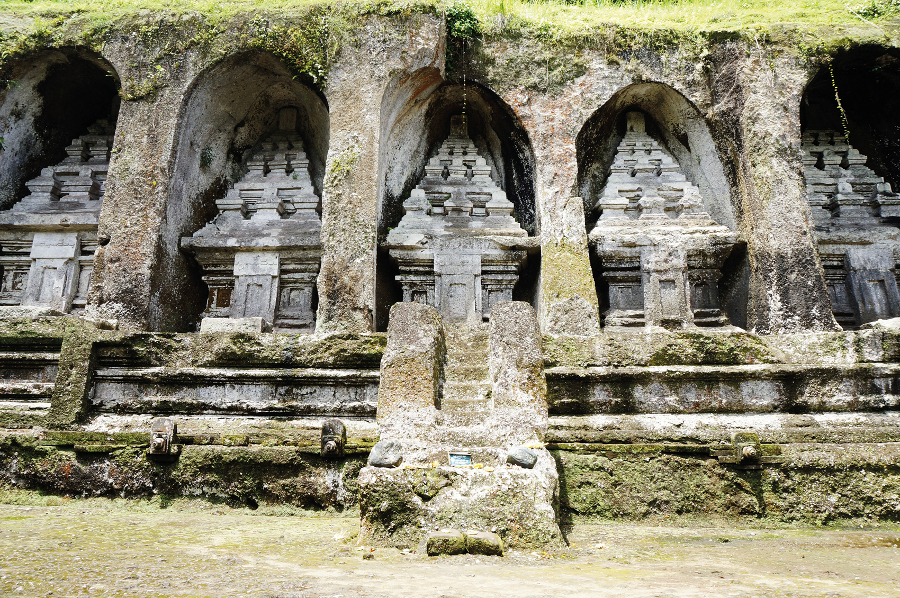
LOCAL LEGEND:
The history of Gunung Kawi dates back to the 11th century. It is said that King Udayana and his queen, Gunapriya Dharmapattni, had three sons: Airlangga, Marakata, and Arak Wungsu. Airlangga went to be the king of Kediri in East Java, whilst Marakata took the throne in Bali after the death of his father; Anak Wungsu became the ruler after Marakata and died in the year 1049 AD.
It is believed that Pura Gunung Kawi was constructed in 1080 AD by King Anak Wungsu in honour of his father and brother. There are small rooms carved in the rock for meditation, or just some quiet time. A little further on, discover the monastery hermitage, where pilgrims from all walks of life come to meditate together.
If you wish to learn more about this site, hire one of the guides offering their services along the way. They tend to be very knowledgeable
YEH PULU
Tucked in the midst of the brilliant natural setting of Batulumbang village in Bedulu, Yeh Pulu houses Bali’s longest sequence of rock relief panels. Yet, despite its beauty, and close proximity from Goa Gajah (only five-minute drive away), it’s odd to learn how Yeh Putu doesn’t receive as many visitors as its neighbouring ancient cave. The combination of fresh air and green paddies can be very rewarding. Meaning ‘water of the stone jar’, this archaeological site is reached after walking through a lush forest trail, rice fields, and freshwater springs. Some parts of the trail are mossy, and can be slippery when wet.
SEE:
Yeh Pulu is a site to marvel at. It is an impressive 25m-long array of carvings etched into a rock face, which portrays the mythological wayang or shadow puppet characters, Hindu gods, as well as people going about normal village life.
The stone relief is divided into several scenes. The first five depict an episode of daily village life that can be seen even today such as a man carrying a pair of water jars on a pole across his shoulders (as seen on the rock wall). Next to the man stands a female figure with a richly adorned headdress and jewellery on her arms, suggesting a high status, perhaps that of a priestess.
Walking through the next scene you’ll find a squatting, turbaned male figure. This figure, deemed as a holy man, is looking outward with his chin resting on his hands in a natural pose. Today, resemblance of the turban can be seen on the headdress of Balinese priests.
There’s also a part of the rock relief that depicts the ancient way of life, a time when men hunted for food. The carvings show a group of hunters, both on horse and on foot hunting for what looks like a boar. The hunter on horseback seems like the one in command, while there are others wrestle and aim a spear at the boar.
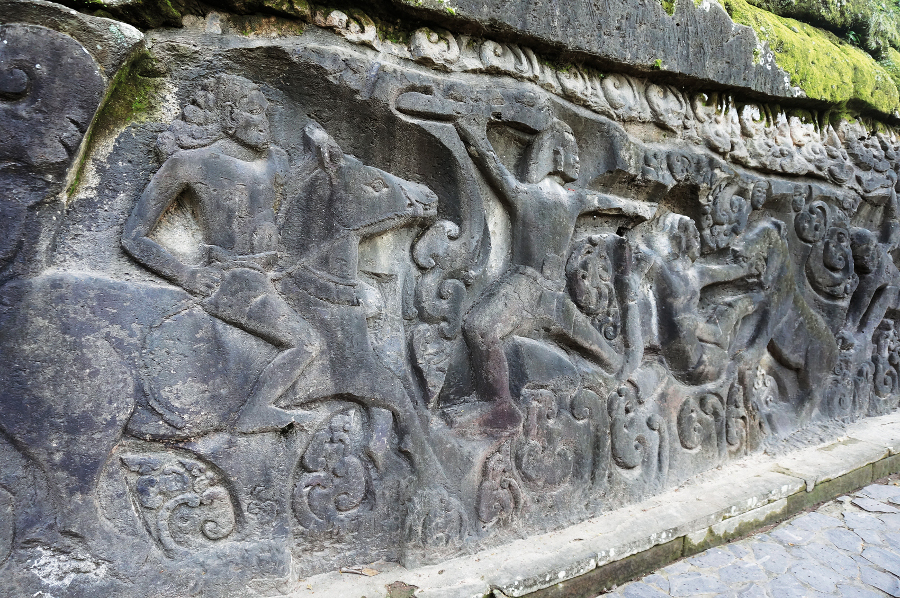
LOCAL LEGEND:
Local legend has it that the rock relief was carved by the giant Kebo Iwa using only his fingernails in the 14th century, during the expansion of Java’s Majapahit Kingdom. It is said that Queen Tribhuwana Wijayatunggadewi instructed her Majapahit troops, who were led by Gajah Mada, to march to Bali in 1343 – Gajah Mada was the Majapahit military commander who defeated Kebo Iwa. The queen attacked the local kingdom of Pejeng before chasing off the king of Pejeng who was meditating at the site where Yeh Putu stands today. It was there that the king was defeated also by Gajah Mada.
1. Menstruating women, and women who have just given birth are not allowed to enter any of the ar-chaeological sites listed here.
2. Proper attire is a must, and both men and women must cover their knees.
3. Wear a sarong. In places such as Goa Gajah, Gunung Kawi, and Yeh Pulu, sarongs are available for loan.
4. Tickets are applied in some of these sites. Where ticket is not available, a donation is generally required (e.g. Pura Kebo Edan).
5. These place are still being used by the local Balinese Hindus as worshipping sites today. It’s important to pay respect to both the praying pilgrims and the sites especially when taking photos.
6. There are parts at these sites that are closed for visitors.







